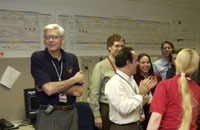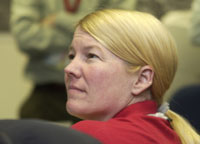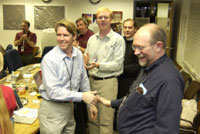| INDEX
Home
Weapons
Photo Galleries
News
Humor
Pages
New
Stuff
Contact Me
|
|
How Did Navigators
Hit Their Precise Landing Target on Mars? |
 |
Dr. Michael Watkins, Navigation and Mission Design
Manager
|
|
 |
 |
Anyone who's been blindfolded and spun around knows how
hard it is to "pin the tail on the donkey,"
even though players are pointed in the right direction
when they last look at their target. To land in a
precise location on Mars after traveling over 300
million miles, navigators at the Jet Propulsion
Laboratory (JPL) had to overcome the head-spinning
challenges of calculating the exact speeds of a rotating
Earth, a rotating Mars, and a rotating spacecraft, while
they all simultaneously are spinning in their own
radical orbits around the Sun.
All the hard work paid off January 3 when navigators
hit their target at the top of the martian atmosphere to
within about 200 meters (660 feet), setting a new
standard for navigation accuracy for all future
interplanetary missions. "The trajectory was so
perfect that not only was it within 200 meters, we also
didn't need to adjust course in the final eight days of
cruise," said Dr. Michael Watkins, navigation and
mission design manager at JPL.
 |
 |
Dr. Louis D'Amario (left) and part of the navigation
team celebrate their bulls-eye at Mars
|
|
 |
Navigators canceled two trajectory correction maneuvers
that were scheduled to correct the flight path by firing
a series of small engine thrusters. The navigation team
researched the exact performance of the engine thrusters
to a tiny fraction of a millimeter per second to ensure
flawless aiming for the four previous maneuvers.
"The Mars Exploration Rover spacecraft design team
helped our ability to navigate precisely in the sense
that they created a dynamically quiet spacecraft. Spirit
didn't thrust much during prior trajectory maneuvers
because the spacecraft was spinning for stability, and
when it did thrust, it did so in a way that was easy for
navigators to predict movement," said Watkins.
Spacecraft thruster firings are a significant effect
navigators have to deal with, but even the seemingly
insignificant solar radiation pressure and thermal
radiation forces acting on the spacecraft to a level
equal to less than a billionth of the acceleration of
gravity one feels on the Earth need to be taken into
account. Without knowing the acceleration error to that
degree, the spacecraft would have moved off course by
3.7 km (2.3 miles) over 10 days.
 |
Navigation team member, Julie Kangas watches as data
from Spirit comes from Mars
|
|
 |
 |
"We had to know everything from how the iron molten
lava in the center of the Earth was churning to how
plate tectonic movements were affecting the wobble of
the Earth to how the plasma in the atmosphere delayed
the radio signals to and from the Deep
Space Network stations," explained Dr. Louis
D'Amario, Mars Exploration Rover navigation team chief.
"We assembled the best navigation team in the world
with experts in orbit determination, propulsive maneuver
design, and entry, descent, and landing trajectory
analysis," said D'Amario. The navigation team has
been working extremely hard on this mission for three
years - they even sacrificed their holidays this
December and New Year's Eve, and they have essentially
worked around the clock for the last two weeks.
Navigators use radio signals sent and received by the
Deep Space Network (DSN) antennas on Earth to compute
spacecraft position and velocity. Three DSN sites are
roughly equally spread around Earth's globe at
120-degree intervals, so that antennas are pointed
toward Mars at any given time as the Earth turns. If the
exact location of any of these antennas is incorrect by
just 5 centimeters (2 inches) on the surface of Earth,
that math error builds over the 150 million kilometers
(90 million miles) distance between Earth and Mars,
creating a 1500-foot (0.3-mile) location error at Mars.
So hitting a precise landing site target that is
scientifically interesting on Mars is impossible unless
the calculations of how fast Earth is rotating on its
own axis is known to the timing of 0.2 milliseconds. At
the other end of the journey, navigators must also know
the location of Mars to the level of accuracy of several
hundred meters. Using recent measurements with Mars
Global Surveyor and Mars Odyssey, navigators know the
location of Mars relative to the Earth to half a mile or
less.
 |
 |
Members of the navigation team after seeing Spirit's
first signal from Mars
|
|
 |
The navigation team's intense attention to detail was
focused on ensuring that this mission would be the most
accurately navigated in history. Navigators ran up to
1,000 different location accuracy solutions several
times every day to cover the full range of possible
answers. The navigation team also used a tongue-tying
tracking technique called spacecraft-quasar delta
differential one-way range or DDOR (pronounced
"Delta Door"), which utilized their knowledge
of locations of quasars to a few billionths of a degree
to help locate the spacecraft's motion in the "up
or down" direction in the sky. "Even though it
was seemingly impossible to reach the small science-rich
landing site inside Gusev Crater, the dedicated
navigation team hit the bulls-eye tonight to put us in
position for a winning science mission," Watkins
said.
|
|